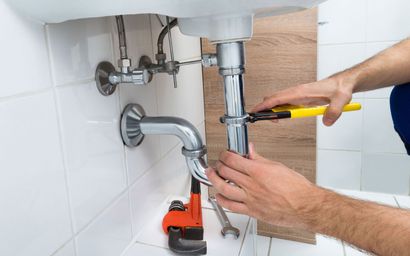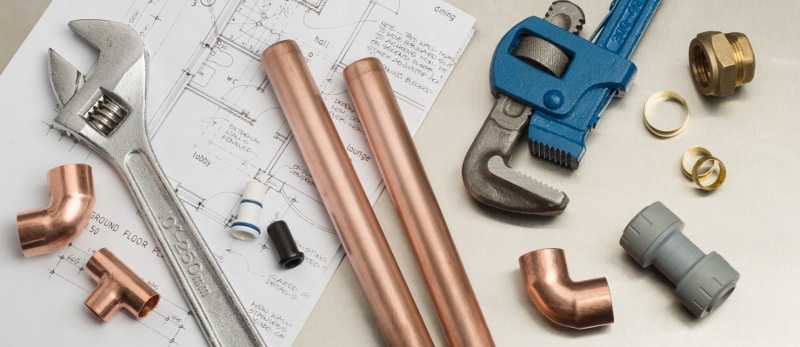Breaking Down The Layout of Your Property's Plumbing System
Breaking Down The Layout of Your Property's Plumbing System
Blog Article
What are your beliefs about The Inner Workings of Your Home's Plumbing?

Recognizing exactly how your home's pipes system functions is important for every single homeowner. From providing clean water for alcohol consumption, food preparation, and bathing to securely removing wastewater, a properly maintained plumbing system is vital for your family members's health and convenience. In this extensive guide, we'll discover the elaborate network that composes your home's plumbing and deal tips on upkeep, upgrades, and handling common problems.
Introduction
Your home's plumbing system is greater than just a network of pipelines; it's an intricate system that ensures you have accessibility to clean water and effective wastewater elimination. Knowing its components and exactly how they work together can assist you protect against costly repair services and ensure everything runs smoothly.
Fundamental Elements of a Plumbing System
Pipes and Tubes
At the heart of your pipes system are the pipes and tubing that lug water throughout your home. These can be made of different products such as copper, PVC, or PEX, each with its benefits in terms of sturdiness and cost-effectiveness.
Fixtures: Sinks, Toilets, Showers, and so on.
Components like sinks, toilets, showers, and tubs are where water is made use of in your home. Understanding exactly how these components connect to the plumbing system assists in detecting problems and planning upgrades.
Valves and Shut-off Factors
Shutoffs regulate the flow of water in your plumbing system. Shut-off valves are vital throughout emergencies or when you need to make repair work, enabling you to separate parts of the system without interfering with water circulation to the whole residence.
Water Supply System
Main Water Line
The main water line links your home to the local water system or an exclusive well. It's where water enters your home and is dispersed to numerous components.
Water Meter and Stress Regulatory Authority
The water meter actions your water use, while a pressure regulator ensures that water flows at a safe pressure throughout your home's plumbing system, avoiding damage to pipes and fixtures.
Cold Water vs. Hot Water Lines
Comprehending the distinction between cold water lines, which supply water directly from the main, and hot water lines, which lug warmed water from the hot water heater, aids in troubleshooting and planning for upgrades.
Drain System
Drain Pipes Piping and Traps
Drain pipes carry wastewater away from sinks, showers, and toilets to the sewer or sewage-disposal tank. Traps avoid sewer gases from entering your home and likewise trap particles that might create obstructions.
Air flow Pipes
Ventilation pipes permit air right into the water drainage system, stopping suction that can reduce water drainage and trigger traps to empty. Proper air flow is crucial for keeping the stability of your plumbing system.
Importance of Correct Water Drainage
Making sure proper water drainage stops backups and water damages. Consistently cleaning drains and keeping catches can protect against expensive repair work and extend the life of your pipes system.
Water Heater
Types of Water Heaters
Hot water heater can be tankless or conventional tank-style. Tankless heaters warmth water on demand, while containers keep heated water for prompt use.
Just How Water Heaters Link to the Plumbing System
Recognizing exactly how water heaters attach to both the cold water supply and hot water distribution lines assists in diagnosing concerns like inadequate hot water or leakages.
Maintenance Tips for Water Heaters
Consistently flushing your hot water heater to remove debris, inspecting the temperature level settings, and inspecting for leakages can extend its life-span and improve power effectiveness.
Usual Plumbing Concerns
Leaks and Their Reasons
Leaks can happen due to maturing pipelines, loose installations, or high water pressure. Resolving leaks without delay stops water damage and mold and mildew growth.
Obstructions and Blockages
Blockages in drains pipes and bathrooms are usually triggered by purging non-flushable items or an accumulation of oil and hair. Utilizing drainpipe screens and being mindful of what drops your drains can stop clogs.
Indications of Pipes Problems to Look For
Low tide pressure, sluggish drains pipes, foul odors, or unusually high water expenses are indicators of potential plumbing troubles that should be dealt with without delay.
Plumbing Maintenance Tips
Routine Inspections and Checks
Set up annual plumbing examinations to catch issues early. Try to find indicators of leaks, corrosion, or mineral accumulation in taps and showerheads.
Do It Yourself Maintenance Tasks
Easy jobs like cleaning tap aerators, looking for commode leaks using dye tablet computers, or protecting subjected pipelines in cool climates can avoid major pipes concerns.
When to Call a Specialist Plumbing
Know when a plumbing problem calls for specialist expertise. Attempting complex repair work without appropriate expertise can bring about even more damages and higher repair prices.
Updating Your Pipes System
Factors for Updating
Updating to water-efficient components or changing old pipelines can improve water quality, reduce water bills, and increase the value of your home.
Modern Plumbing Technologies and Their Benefits
Explore technologies like smart leak detectors, water-saving toilets, and energy-efficient water heaters that can save money and reduce environmental influence.
Price Factors To Consider and ROI
Compute the in advance expenses versus long-lasting cost savings when thinking about plumbing upgrades. Numerous upgrades pay for themselves through lowered energy expenses and fewer repair work.
Environmental Impact and Conservation
Water-Saving Components and Devices
Setting up low-flow faucets, showerheads, and bathrooms can considerably reduce water usage without giving up efficiency.
Tips for Minimizing Water Usage
Simple habits like dealing with leaks promptly, taking much shorter showers, and running full loads of washing and recipes can save water and lower your energy costs.
Eco-Friendly Plumbing Options
Consider lasting pipes materials like bamboo for flooring, which is durable and eco-friendly, or recycled glass for kitchen counters.
Emergency Preparedness
Actions to Take Throughout a Plumbing Emergency situation
Know where your shut-off shutoffs are located and just how to shut off the supply of water in case of a burst pipeline or major leak.
Relevance of Having Emergency Contacts Convenient
Keep contact details for regional plumbers or emergency services easily available for fast reaction during a pipes crisis.
Do It Yourself Emergency Fixes (When Relevant).
Momentary solutions like using air duct tape to patch a dripping pipe or positioning a container under a dripping tap can minimize damages until a specialist plumbing gets here.
Conclusion.
Recognizing the anatomy of your home's pipes system empowers you to keep it efficiently, conserving time and money on repair services. By following routine upkeep routines and remaining informed regarding modern plumbing innovations, you can guarantee your plumbing system operates successfully for years ahead.
HOW YOUR PLUMBING SYSTEM WORKS
Which Pipes Do What?
Blue lines = fresh water supply entering the building
Red lines = hot water supply entering the building
Grey lines = pipes carrying waste away from the building and venting pipes carrying gases away from the building (through the roof)
YOUR MAIN PLUMBING SYSTEMS
There are two main plumbing systems that support your home s basic plumbing needs one that brings clean water into your home, and one that sends dirty water away from your home. Connected to the toilet, bath, shower, and other faucets in your home, these two systems keep your water flowing in the right directions.
ACCESSING FRESH WATER
Fresh and clean water is brought into your home through the main water supply line . Filtered through one pipe, this water is pressured to flow into the various fixtures in your home at any given time.
This water can be sourced from a well located on your property, a pond or river (mostly cottages), or, as in most cases, from the city s municipal water treatment centre. However, it is important to note that water that is untreated, such as the water siphoned from ponds or rivers, may not be safe to drink. Personal water supplies always need to be treated for hardness and contaminants before consumed.
MUNICIPAL WATER SUPPLIES
Improve taste and odour
Remove sediment
Eliminate hardness
Reduce chlorine
COLD WATER SUPPLY VS. HOT WATER SUPPLY
Cold water flows into your home or building through the service line, which then distributes hot or cold water to your fixtures. This line is most commonly run through a central column that runs floor to floor. Hot water runs in short and straight pipes as the longer the pipeline, the more heat that will be lost in the transfer. Having shorter pipes also allows residents to access hot water more quickly.
WASTE WATER SYSTEM
Your wastewater system is divided into two parts pipes that send wastewater away from your home and venting pipes that send sewer gas away from your home. Sewage water travels through pipes that flush the water and waste towards local sewers that are operated and managed by your city or town. Most sewer systems rely on gravity to move the wastewater to where it needs to go.
The further away from your toilet or sink, the larger wastewater pipes become. This allows for waste to be disposed of from various parts of your home or business at once without pipe blockages. The angle and flow of these pipes are also essential for keeping your waste pipes clear of build up.
https://harrisplumbing.ca/how-your-home-plumbing-system-works/

HOW YOUR PLUMBING SYSTEM WORKS
Which Pipes Do What?
YOUR MAIN PLUMBING SYSTEMS
There are two main plumbing systems that support your home s basic plumbing needs one that brings clean water into your home, and one that sends dirty water away from your home. Connected to the toilet, bath, shower, and other faucets in your home, these two systems keep your water flowing in the right directions.
ACCESSING FRESH WATER
Fresh and clean water is brought into your home through the main water supply line . Filtered through one pipe, this water is pressured to flow into the various fixtures in your home at any given time.
This water can be sourced from a well located on your property, a pond or river (mostly cottages), or, as in most cases, from the city s municipal water treatment centre. However, it is important to note that water that is untreated, such as the water siphoned from ponds or rivers, may not be safe to drink. Personal water supplies always need to be treated for hardness and contaminants before consumed.
MUNICIPAL WATER SUPPLIES
COLD WATER SUPPLY VS. HOT WATER SUPPLY
Cold water flows into your home or building through the service line, which then distributes hot or cold water to your fixtures. This line is most commonly run through a central column that runs floor to floor. Hot water runs in short and straight pipes as the longer the pipeline, the more heat that will be lost in the transfer. Having shorter pipes also allows residents to access hot water more quickly.
WASTE WATER SYSTEM
Your wastewater system is divided into two parts pipes that send wastewater away from your home and venting pipes that send sewer gas away from your home. Sewage water travels through pipes that flush the water and waste towards local sewers that are operated and managed by your city or town. Most sewer systems rely on gravity to move the wastewater to where it needs to go.
The further away from your toilet or sink, the larger wastewater pipes become. This allows for waste to be disposed of from various parts of your home or business at once without pipe blockages. The angle and flow of these pipes are also essential for keeping your waste pipes clear of build up.
https://harrisplumbing.ca/how-your-home-plumbing-system-works/
I came across that page on Understanding Your Home's Plumbing Anatomy when exploring the web. Do you know about somebody who is excited by The Inner Workings of Your Home's Plumbing? Be sure promote it. Thanks so much for your time invested reading it.
Call Today Report this page